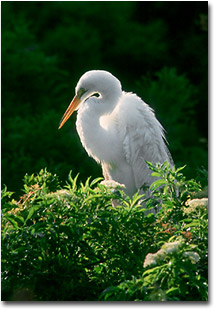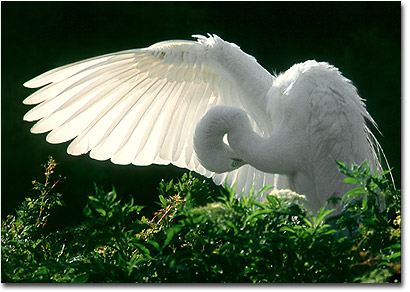|
|
 Vision Bird: A Photograph Three Years in the Making Photography and Text Copyright Gloria Hopkins Have you ever wished you could photograph a bird in a certain pose or on a certain perch? How about a bear displaying a particular behavior in a setting of your choice? I know many photographers who have a “dream shot” and it’s usually something that gets them very excited when talking and thinking about it. Visualizing photographs that you would like to take someday is a healthy, pleasurable and educational exercise for photographers of all skill levels. At present I have six pre-visualized bird images that I would love to capture on film. I call these my “vision birds” and they exist only in my imagination and sketchbooks. For each of these images I have the composition, pose and behavior, lighting and exposure values all figured out. All I need to do is put myself in the right situation for the opportunity. Last year I found my first vision bird at the Alligator Farm in St. Augustine, Florida. I had dreamed of this image since I saw my first Great Egret in 1999, many months before buying my first camera. I was touring the boardwalk at Wakodahatchee Wetlands looking for songbirds when I turned the corner and found myself standing before the most breathtaking creature I had ever seen. According to my field guide, it was a Great Egret. It was perched atop a small pond apple tree, leisurely preening against a strong orange sun. It was daybreak and smoke from a distant fire cast a light yellow haze over Wakodahatchee. The bird was magnificent as it preened. The backlighting created a halo around the bird, giving it an angelic presence. The way the light moved through its long, wispy back plumes transformed them into sparkling strands of golden silk blowing softly in the cool morning breeze. When the bird stretched its wing against the big orange sun, the long, translucent primaries flashed in the sun and I was awestruck. I felt as if I were witnessing grace and elegance for the first time. I desperately wanted to touch this bird. I wanted to know what something that beautiful felt like. I was mesmerized by this vision dancing before me in sweet, golden light. Since that day I have not been able to get that bird out of my mind. I have sketched it a dozen times and even started several paintings. My endless pursuit of this image has inadvertently launched a passion for shooting backlit birds of all sizes and shapes. It is great fun and I really like some of the images, but until last year I remained in search of my vision bird perched atop the pond apple.
While shooting a nest at the Alligator Farm in May 2002, I turned back to see how the sun was falling on the birds behind me. From the corner of my eye I saw the big white bird hop gracefully from its nest up to the small tree, right between the sun and me. My heart hit the ground and I trembled with adrenaline. The image that had haunted me for three years was within reach. Knowing the patterns of the nesting birds there, I knew there was good chance that it would stay on the tree and preen for awhile before flying off to forage. This gave me the extra time I needed to get set up with shaking hands and a rapidly beating heart. I took many photos of that bird preening and by a stroke of luck it finally stretched its wing. Trying my best to steady my hands and breathe regularly, I got two clean shots. I was a ball of nerves waiting to get the slides back and when I saw the slides on the light box I beamed from the inside-out. All I could say was “Oh My Lord” over and over again. They were almost exactly as I had envisioned them and perfectly executed. For an artist there’s not a more satisfying feeling in the world than to see a vision to fruition. I’d gladly wait another three years for the next opportunity. Having given this topic considerable thought, I realize that most nature photography is impossible to arrange or predict. There are some captive and in-studio set-up shots that are done, but in general, animals won’t listen and mountains are hard to move. The point of pre-visualizing your images is not to dream of an image that is unattainable, but to practice the exercise to reap its many benefits, which include:
Although I have these vision birds that I would like to capture someday, and plans for their execution, I understand how important spontaneous shooting and experimentation is to the creative soul. Just as setting out in the field and letting nature guide your camera can be a wonderful creative release, pre-visualizing images and thinking about how you would make the photograph can be as healthy as a form of meditation at home. When and if you ever capture your vision bird, you will find that it can be one of the most personally satisfying experiences that an artist can have. You may wonder what there is to think about when trying to pre-visualize a photograph. In my preening great egret shot it is a bird, a pose, and some vegetation. Not much to think about, right? Wrong. For that shot, here are some of the things I thought about and solved way before the opportunity presented itself: was the texture of the feathers shiny or rough? How will that look on film? Aside from the wing stretch, what does the bird look like? Is it looking at the camera or preening or looking elsewhere? How does that cause the sun to fall on its head and face? What is in the background and how light or dark is it? What are the other elements I want in my picture? What kind of exposure compensation should I use and how much? What kind of film? Should I shoot in early or late light? All these questions and answers may seem frivolous and a waste of time. You might think the situation would probably never present itself the way you imagine anyway, so why waste time thinking about it? Because thinking about it will help you make decisions in the field in other situations. You go through various scenarios in your mind and they force you to think about things like image design, exposure, light, etc. I had about five minutes with my great egret and although the background and foliage are not exactly what I had in mind, and the near wing is a bit of a mess, I wasted not a single second, nor a single frame. I’ve been accused of being a dreamer with little direction and discipline in my life. I’ve even been told that I need someone to run my life so I can spend all my time creating images and not worry about real life stuff. This isn’t nice to hear but I don’t mind being a dreamer of beautiful visions. When people get me down, I retreat to the quiet of my studio and look around at some of my paintings and photographs. There, on the wall beside my bed, hangs a small reminder that with a little perseverance, dreams really can come true.
IMAGE INFORMATION: Editor's Note - Be sure to visit Gloria's web site at www.naturesglory.net to view more of her work. Gloria Hopkins - NPN 089 Comments on NPN photographic composition articles? Send them to the editor. |
|
|

